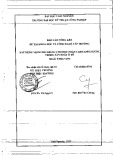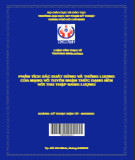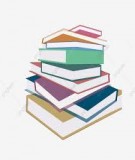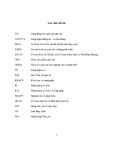
Overexpression of putative topoisomerase 6 genes from
rice confers stress tolerance in transgenic Arabidopsis
plants
Mukesh Jain, Akhilesh K. Tyagi and Jitendra P. Khurana
Interdisciplinary Centre for Plant Genomics and Department of Plant Molecular Biology, University of Delhi South Campus, New Delhi, India
DNA topoisomerases are ubiquitous enzymes that
induce transient breaks in DNA allowing DNA
strands or double helices to pass through each other
and re-ligate the broken strand(s). They thus relieve
topological constraints in chromosomal DNA gener-
ated during many fundamental biological processes
such as DNA replication, transcription, recombination
and other cellular transactions. They have been classi-
fied into two types, according to their ability to cleave
one (type I) or both (type II) strands of a DNA double
helix [1,2]. Type II topoisomerases can be divided into
two subclasses: type IIA and type IIB [3,4].
DNA topoisomerase 6 (TOP6) is the only member
of the type IIB subclass found in Archaea [1,3] that
generates ATP-dependent double-strand breaks with
two-nucleotide overhangs in A
2
B
2
heterotetrameric
Keywords
gene expression; rice (Oryza sativa); stress
tolerance; topoisomerase 6; transgenic
Arabidopsis
Correspondence
J. P. Khurana, Department of Plant
Molecular Biology, University of Delhi South
Campus, Benito Juarez Road, New Delhi
110021, India
Fax: +91 011 24115270 or
+91 011 24119430
Tel: +91 011 24115126
E-mail: khuranaj@genomeindia.org
Database
Sequence data from this article have been
deposited in the GenBank ⁄EMBL database
under the accession numbers AJ549926
(OsTOP6A1), AJ605583 (OsTOP6A2),
AJ550618 (OsTOP6A3), and AJ582989
(OsTOP6B). Microarray data from this article
have been deposited in Gene Expression
Omnibus (GEO) repository at NCBI under
the series accession number GSE5465
(Received 4 July 2006, revised 28
September 2006, accepted 2 October 2006)
doi:10.1111/j.1742-4658.2006.05518.x
DNA topoisomerase 6 (TOP6) belongs to a novel family of type II DNA
topoisomerases present, other than in archaebacteria, only in plants. Here
we report the isolation of full-length cDNAs encoding putative TOP6 sub-
units A and B from rice (Oryza sativa ssp. indica), preserving all the struc-
tural domains conserved among archaebacterial TOP6 homologs and
eukaryotic meiotic recombination factor SPO11. OsTOP6A1 was predom-
inantly expressed in prepollinated flowers. The transcript abundance of
OsTOP6A2,OsTOP6A3 and OsTOP6B was also higher in prepollinated
flowers and callus. The expression of OsTOP6A2,OsTOP6A3 and
OsTOP6B was differentially regulated by the plant hormones, auxin, cyto-
kinin, and abscisic acid. Yeast two-hybrid analysis revealed that the full-
length OsTOP6B protein interacts with both OsTOP6A2 and OsTOP6A3,
but not with OsTOP6A1. The nuclear localization of OsTOP6A3 and
OsTOP6B was established by the transient expression of their b-glucuroni-
dase fusion proteins in onion epidermal cells. Overexpression of
OsTOP6A3 and OsTOP6B in transgenic Arabidopsis plants conferred
reduced sensitivity to the stress hormone, abscisic acid, and tolerance to
high salinity and dehydration. Moreover, the stress tolerance coincided
with enhanced induction of many stress-responsive genes in transgenic Ara-
bidopsis plants. In addition, microarray analysis revealed that a large num-
ber of genes are expressed differentially in transgenic plants. Taken
together, our results demonstrate that TOP6 genes play a crucial role in
stress adaptation of plants by altering gene expression.
Abbreviations
ABA, abscisic acid; GUS, b-glucuronidase; PP, prepollinated; TOP6, DNA topoisomerase 6.
FEBS Journal 273 (2006) 5245–5260 ª2006 The Authors Journal compilation ª2006 FEBS 5245

organization [5,6]. The TOP6 subunit A (TOP6A) has
only the Toprim domain [4,7] homologous to type IIA
topoisomerases. Outside the Toprim domain, TOP6A
shares general homology with SPO11, a protein
involved in inducing double-strand breaks to initiate
meiotic recombination in eukaryotes [8,9]. Their exist-
ence has also been shown in plants [10–14]. In contrast
with other eukaryotes, plants contain three potential
homologs of archaebacterial TOP6A in their genome
[10,11]. AtSPO11-1 in Arabidopsis has been found to
have a role in meiotic recombination [15], similar to
SPO11 proteins in other eukaryotes. AtSPO11-3 and
AtTOP6B are involved in endoreduplication [13] and
plant growth and development [14]. However, the
function of AtSPO11-2 is still not known.
Even though TOP6 has been characterized biochemi-
cally in archaebacteria, its role in eukaryotes has not yet
been documented, as a homolog of subunit B is missing
from all eukaryotes except plants. In this study, we iso-
lated the homologs of archaebacterial TOP6A and
TOP6B from rice (Oryza sativa indica), the model mono-
cot plant. The detailed tissue-specific expression and
hormonal regulation of rice TOP6 genes is reported.
The interaction of subunit B with two of the subunit A
homologs could also be demonstrated by the yeast two-
hybrid assay. In addition, we show that the overexpres-
sion of nuclear-localized OsTOP6A3 and OsTOP6B
protein genes confers increased stress tolerance in trans-
genic Arabidopsis plants.
Results
cDNA cloning
The homologs of TOP6 in rice were identified by a
tblastn search of rice genomic sequence using the
TOP6A and TOP6B protein sequences of a hyperther-
mophilic archaebacterium, Sulfolobus shibatae,as
query. This search resulted in the identification of
three putative homologs for TOP6A and one for
TOP6B protein in rice with high sequence similarity
within all the conserved motifs. The corresponding
full-length cDNAs were isolated by a combination of
RT-PCR and RACE, using gene-specific primers. The
three subunit A genes in rice were designated
OsTOP6A1,OsTOP6A2, and OsTOP6A3. Earlier,
their orthologs in Arabidopsis were named as
AtSPO11-1,AtSPO11-2, and AtSPO11-3, on the basis
of their homology to meiotic recombination protein,
SPO11, of Saccharomyces cerevisiae [10,11]. The sub-
unit B homolog was designated OsTOP6B.5¢-RACE
and 3¢-RACE for each gene amplified a single PCR
product, except for 3¢-RACE of OsTOP6A3, which
gave different-size products. The largest product was
sequenced; it showed the presence of more than 10 dif-
ferent polyadenylation signals distributed over the
entire 3¢-UTR of OsTOP6A3 (Fig. 1). Comparison of
genomic (obtained from the TIGR rice genomic
sequence using blast search tools) and cDNA
sequences identified the predicted exons and introns in
the OsTOP6 genes (Fig. 1). The GenBank accession
number, length of the ORF, number of exons and
introns, and predicted protein length for each gene are
given in supplementary Table S1. The blast search
of the TIGR database showed that all the TOP6
genes are represented as a single copy in the rice
genome. OsTOP6A1 and OsTOP6A3 are located on
chromosome 3 at different positions, OsTOP6A2 on
chromosome 8, and OsTOP6B on chromosome 9
(supplementary Table S1).
Sequence analysis
The multiple sequence alignment of the deduced
amino-acid sequences of the three OsTOP6A proteins
showed the presence of all five conserved motifs and
residues (supplementary Fig. S1), found in other
SPO11 ⁄TOP6A homologs [3,4,7,16]. Overall, rice
TOP6A amino-acid sequences are 56–68% identical
with Arabidopsis SPO11 homologs, 18–32% with
animal proteins, 13–24% with yeast SPO11 proteins,
and 16–27% with archaebacterial TOP6A proteins.
Fig. 1. The exon–intron organization of puta-
tive rice TOP6A and TOP6B genes. The
coding and untranslated regions are repre-
sented by black and open boxes, respect-
ively. The introns are represented by lines.
Start and stop codons are indicated by
arrows. Polyadenylation signals are repre-
sented by asterisks. The two large introns in
the OsTOP6B gene are represented by
interrupted lines.
Role of topoisomerase 6 genes in stress tolerance M. Jain et al.
5246 FEBS Journal 273 (2006) 5245–5260 ª2006 The Authors Journal compilation ª2006 FEBS

The regional similarity was much higher particularly
in the five conserved motifs. OsTOP6A proteins con-
tain the active tyrosine residue within the CAP
domain, which is invariant among other SPO11
homologs and has been shown to be necessary for
double-strand break induction in S. cerevisiae [3,16].
The conserved DXD sequence of the Toprim
domain, which is thought to co-ordinate Mg
2+
ion
required for DNA binding and may also assist in
strand cleavage and re-ligation reactions [4], was pre-
sent in OsTOP6A1 and OsTOP6A3, but absent from
OsTOP6A2. Notably, OsTOP6A3 protein showed the
presence of an N-terminal extension that is not pre-
sent in OsTOP6A1 and OsTOP6A2. The OsTOP6B
protein also harbors all the conserved domains
(N-terminal GHKL, middle H2TH, and C-terminal
transducer domain) and the motifs of the Bergerat
fold (motif B1-B3) found in other TOP6B homologs
(Fig. S1) [3,11], showing an overall sequence identity
of 69.6% with Arabidopsis and 15–30% with archae-
bacterial TOP6B homologs.
The amino-acid sequence analysis of rice TOP6 pro-
teins also predicted several potential putative phos-
phorylation sites for casein kinase II, protein kinase C,
tyrosine kinase, histidine kinase, cAMP-dependent and
cGMP-dependent protein kinases, and putative N-gly-
cosylation, N-myristoylation and amidation. It is
known from other studies that the activity of topo-
isomerases is modulated by these post-translational
modifications [17,18]. These potential post-transla-
tional modification sites in the primary amino-acid
sequence remain to be functionally validated.
Intron conservation and phylogenetic analysis
The position and phasing of introns was found to be
highly conserved between the respective rice and Ara-
bidopsis SPO11 ⁄TOP6 genes (Fig. S2), suggesting that
these genes may have evolved from a common ances-
tor. The AtSPO11-1 and AtSPO11-2 genes were previ-
ously found to possess one intron in their 3¢-UTRs
[10]. However, no intron was found in the 3¢-UTRs of
OsTOP6A1 and OsTOP6A2, as a single 3¢-RACE
product was amplified for both genes in repeated
experiments. Also, intron 2 of AtSPO11-2 and the only
intron present in the ORF of AtSPO11-3 genes
(Fig. S2) are absent from rice OsTOP6A2 and
OsTOP6A3 genes, respectively. From these observa-
tions, it can be speculated that Arabidopsis has gained
the intron present in the 3¢-UTRs of AtSPO11-1
(intron 15) and AtSPO11-2 (intron 11), and rice has
lost intron 2 and intron 1 from the OsTOP6A2 and
OsTOP6A3 genes, respectively, during the course of
evolution after divergence into dicots and monocots,
according to the assumptions of Hartung et al. [19].
Phylogenetic analysis of SPO11 ⁄TOP6A homologs
from different organisms (Fig. S3) showed that
OsTOP6A1 is more closely related to SPO11 homologs
from other organisms, whereas OsTOP6A2 and
OsTOP6A3 were more closely related to archaebac-
terial TOP6A proteins. Moreover, OsTOP6A proteins
are significantly more closely related to SPO11 ⁄TOP6A
proteins from other organisms than each other, indica-
ting that TOP6A genes in rice did not arise by recent
duplications, but rather represent ancient paralogs.
Also, OsTOP6B appears to be closely related to
AtTOP6B and archaebacterial TOP6B proteins. Other
than in plants, TOP6B protein is only present in
archaebacteria. Thus, it can be speculated that TOP6
was acquired by plants from Archaea by lateral gene
transfer. From a comparison of intron positions and
phylogenetic trees, it has been postulated that the evo-
lution of AtSPO11-1 and AtSPO11-2 (orthologs of
OsTOP6A1 and OsTOP6A2)inArabidopsis occurred
as the result of duplication of an ancestral SPO11 gene
present in the last common ancestor of plants and
animals, shortly after the divergence of plants and ani-
mals [19]. The evolution of AtSPO11-3 (ortholog of
OsTOP6A3) has been proposed to have occurred by
reintegration of a partially spliced mRNA of
AtSPO11-2 into the genome by a reverse transcription
mechanism [19]. However, the evolution of TOP6
genes in plants remains a matter of debate. Sequencing
of complete genomes of other organisms, including
lower plants, will hopefully help to answer this
question.
Tissue-specific expression and hormonal
regulation
To examine the expression of OsTOP6 genes in differ-
ent plant organs, quantitative real-time RT-PCR ana-
lysis was performed from total RNA isolated from
6-day-old seedlings, young roots, young shoots, callus,
prepollinated (PP) and postfertilized flowers. This ana-
lysis showed that the OsTOP6A1 gene was predomin-
antly expressed in PP flowers (Fig. 2A,C), which are
principally composed of meiotic cells. However, it was
also found to be expressed in tissues other than PP
flowers, although at lower level (Fig. 2A,C). Several
larger transcripts were also found at low levels in PP
flowers and other tissues examined by semi-quantita-
tive RT-PCR using gene-specific primers (Fig. 2A).
Similar observations have been made in the case of
Arabidopsis [10] and mammalian [20] SPO11 homologs.
However, the biological significance of these alternat-
M. Jain et al.Role of topoisomerase 6 genes in stress tolerance
FEBS Journal 273 (2006) 5245–5260 ª2006 The Authors Journal compilation ª2006 FEBS 5247

ive transcripts is not known. OsTOP6A2 is expressed
at much lower level than other OsTOP6 genes in all
the tissues examined, as exemplified by comparative
analysis of the expression data obtained with PP flow-
ers (Fig. 2B). OsTOP6A2 was found to be expressed in
PP flowers and callus at significant levels (Fig. 2C).
This indicates that it may have a role in meiosis and
somatic cell division. OsTOP6A3 and OsTOP6B were
constitutively expressed in all the plant tissues ⁄organs
tested, although quantitative variation in transcript
levels was observed (Fig. 2C).
Further, real-time PCR analysis was performed to
quantify the mRNA concentrations of OsTOP6 genes
after treatment of rice seedlings with different plant
hormones (Fig. 3). OsTOP6A1 did not show any
response to the hormones tested in this study. How-
ever, the transcript levels of OsTOP6A2,OsTOP6A3
and OsTOP6B were up-regulated 2–3-fold after treat-
ment with auxin and cytokinin (Fig. 3), indicating their
role in cell division. Also, the transcript abundance of
OsTOP6A3 and OsTOP6B increased up to 3–5-fold in
the presence of abscisic acid (ABA) within 3 h in rice
seedlings (Fig. 3).
Interaction of rice TOP6B protein with TOP6A
homologs
TOP6 in archaebacteria causes double-strand breaks in
heterotetrameric (A
2
B
2
) form [5,6]. To ascertain the
possible interaction of putative TOP6B with TOP6A
homologs in rice, yeast two-hybrid analysis was per-
formed. The results clearly show that OsTOP6B only
interacts with the OsTOP6A2 and OsTOP6A3 but not
with OsTOP6A1 (Fig. 4), an observation essentially
similar to that reported in Arabidopsis [11]. However,
we could not detect the interaction of partial
OsTOP6B (pTOP6B, amino acids 1–420) lacking the
C-terminal transducer domain with any of the
OsTOP6A homologs (Fig. 4). It substantiates the idea
that the transducer domain of TOP6B is involved in
interaction with TOP6A and structurally transduces
appropriate signals to it [21].
BA
C
Fig. 2. Tissue-specific expression of OsTOP6 genes. (A) Semi-quantitative RT-PCR analysis of OsTOP6A1 in different tissues (indicated at
the top of each lane) using gene-specific primers. Arrowheads represent alternative transcripts of OsTOP6A1.ACTIN represents the internal
control. (B) Relative expression of the four rice TOP6 genes in PP flowers assessed using real-time PCR. mRNA levels were calculated relat-
ive to the expression of OsTOP6A2. (C) Quantitative real-time RT-PCR analysis for expression of individual rice TOP6 genes in different tis-
sues as indicated below each bar (SL, 6-day-old seedlings; S, young shoots; R, young roots; PP, prepollinated flowers; PF, postfertilized
flowers; C, callus). The mRNA levels in different tissues for each candidate gene were calculated relative to the expression in 6-day-old
seedlings. For each tissue, the same cDNA sample was used to study the expression of the different genes.
Role of topoisomerase 6 genes in stress tolerance M. Jain et al.
5248 FEBS Journal 273 (2006) 5245–5260 ª2006 The Authors Journal compilation ª2006 FEBS

Subcellular localization of OsTOP6A3
and OsTOP6B proteins
The OsTOP6A3 and OsTOP6B genes encode highly
basic (OsTOP6A3, pI 9.30; OsTOP6B, 8.94) proteins.
To establish the subcellular localization of these pro-
teins, the complete ORFs of these genes were fused
in-frame with the b-glucuronidase (GUS) gene, and
expressed transiently under the control of CaMV 35S
promoter. The recombinant vectors and pCAMBIA
3301 (cytosolic control) were bombarded into the inner
epidermal cells of white onion. Subcellular localization
of fusion proteins (OsTOP6A3::GUS and OsTOP6B::
GUS) and GUS protein was established using GUS
histochemical assay buffer. Both the fusion proteins
were found to be concentrated in the nucleus, whereas
the GUS protein alone was distributed all over the cell
(Fig. 5). Staining with the nucleus-specific dye Hoechst
33258 confirmed the nuclear localization.
Overexpression of OsTOP6A3 and OsTOP6B
in Arabidopsis
To establish the functional significance of the TOP6A
and TOP6B homologs, OsTOP6A3 and OsTOP6B,
respectively, we generated transgenic Arabidopsis plants
in which the complete ORFs of OsTOP6A3 and
OsTOP6B were overexpressed under the control of
Fig. 4. Yeast two-hybrid analysis showing the interaction of OsTOP6B protein with OsTOP6A2 and OsTOP6A3. AD-TOP6A1, AD-TOP6A2
and AD-TOP6A3 denote the fusion of full-length OsTOP6A1, OsTOP6A2 and OsTOP6A3 with GAL4 activation domain, respectively.
BD-TOP6B and BD-pTOP6B represents the fusion of full-length and partial OsTOP6B with GAL4 DNA-binding domain, respectively. The
interaction of BD-53 (fusion of p53 with GAL4 DNA-binding domain) with AD-T (fusion of antigen T with activation domain) and AD-Lam
(fusion of lamin C with activation domain) represents the +ve and –ve controls, respectively.
Fig. 3. Hormonal regulation of OsTOP6 genes. Total RNA extracted from 6-day-old light-grown seedlings harvested after treatment with
10 lMepibrassinolide (Br), 50 lMindole-3-acetic acid (IAA), 50 lMbenzylaminopurine (BAP), 50 lMgibberellic acid (GA), 50 lM1-aminocyclo-
propane-1-carboxylic acid (ACC), or 50 lMabscisic acid (ABA) for 3 h was used for real-time PCR quantification of expression levels. mRNA
levels were calculated relative to the expression in mock-treated rice seedlings (kept in water) for each gene. For each tissue, the same
cDNA sample was used to study the expression of the different genes.
M. Jain et al.Role of topoisomerase 6 genes in stress tolerance
FEBS Journal 273 (2006) 5245–5260 ª2006 The Authors Journal compilation ª2006 FEBS 5249


























